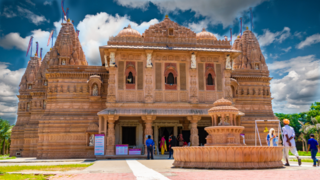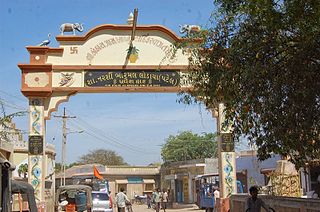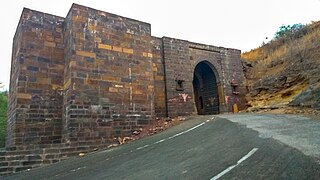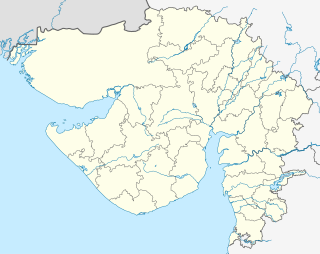
Lakhpat is a sparsely populated town and sub-district in the Kachchh district in the Indian state of Gujarat located at the mouth of the Kori Creek. The town is enclosed by 7km-long, 18th-century fort walls.

Chandravati, popularly known as Chandroti, is a village situated near Abu Road on the bank of the West Banas River in the Indian state of Rajasthan. In ancient times it was an extensive town, and present villages such as Dattani, Kiverli, Kharadi and Santpura were its suburbs. The old ruins, such as temples, torans and images scattered over the large area, bear testimony to its past glory.

Bhadresar or Bhadreshwar is a village in Mundra Taluka, Kutch district of Gujarat, India. It is about 27 km from Taluka headquarters Mundra and barely a kilometer away from the seashore.

Koteshwar is a small village and the location of an ancient Shiva temple. It located near the mouth of Kori Creek, in the west of Kutch district of Gujarat, India.

Narayan Sarovar or Narayansar is a village and place of pilgrimage for Hindus on the Kori Creek. It is located in Lakhpat taluka of Kutch district, Gujarat, India. The ancient Koteshwar temple lies only 4 km away.

Mata no Madh is a village in Lakhpat Taluka of Kutch district, Gujarat, India. The village lies surrounded by hills on both banks of a small stream and has a temple dedicated to Ashapura Mata, the household deity of former Jadeja rulers of kutch State. She is also considered patron deity of Kutch. The village is located about 105 km from Bhuj, the headquarters of Kutch district.

Kothara is a village and a Jain pilgrimage center located in Abdasa Taluka of Kutch district of Gujarat, India.

Kanthkot fort is located near Kanthkot village, Bhachau Taluka of Vagad area, Kutch, Gujarat.
Bhuvad is a village of Ahir [Zaru] And Rathod or rathore Rajput Kshatriya in Anjar Taluka of Kutch district of Gujarat, India.
Katariya is a village in Bhachau Taluka of Kutch district of Gujarat, India. The villages is now divided into two parts; Juna (old) and Nava (new) Katariya.

Kera is a village in Bhuj Taluka of Kutch district of Gujarat, India. This historical town has several places of interest; the ruins of an old fort and Shiva temple, and the shrine of a Muslim saint Ghulam Ali.

Jakh Botera, Jakhdada, Jakkha Bautera, 72 Yaksha or Bohter Yaksha, literally seventy-two Yaksha warriors, are group of folk deities worshiped widely in Kutch district of Gujarat, India.
Kanoj, formerly known as Ra Kanoj, was a town destroyed whose ruins are stretched for a mile. They are located in Lakhpat Taluka of Kutch district of Gujarat, India.
Rav is a village of three hamlets; Rav Moti, Rav Nani and Temple; in an open plain, located nineteen miles from Chobari, in Rapar Taluka of Kutch district of Gujarat, India.
Sikra is a village in Bhachau Taluka of Kutch district of Gujarat, India.

Vinzan or Vinjhan is a village in Abdasa Taluka in Kutch district of Gujarat, India.
Patgadh or Vagham Chavdagadh was a historical town and capital of western Kutch during rule of Chawda dynasty. The ruins of the town is located in Lakhpat Taluka in Kutch district of Gujarat, India. The village is on the west bank of Little Rann of Kutch.
Kasara is a village in Kankrej Taluka of Banaskantha district in Gujarat, India.

The Shiva temple, Kera, also known as Lakheshwara temple of Kerakot, is located in Kera village near Bhuj of Kutch district in Gujarat, India. The temple was built during the reign of the Chaulukya dynasty (Solankis) in the later part of the 10th Century and is dedicated to Shiva. The temple has been subjected to severe earthquake damages during the earthquake of 1819 and the Bhuj earthquake of 2001. But the temple's spire, inner sanctum and the sculptures are still in an attractive condition.

The Shantinath Jain temple is located in Kothara of Kutch district, Gujarat, India. The temple is dedicated to Shantinatha and is an important place of pilgrimage for the followers of Jainism.













